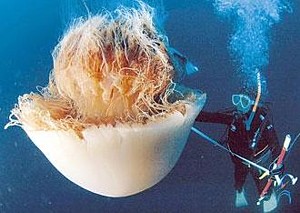 In the latest development in Japan's war against giant jellyfish invaders, scientists studying the biochemistry of echizen kurage (Nomura's jellyfish) have discovered a previously unknown type of mucin in the sea creatures.
In the latest development in Japan's war against giant jellyfish invaders, scientists studying the biochemistry of echizen kurage (Nomura's jellyfish) have discovered a previously unknown type of mucin in the sea creatures.
Mucins, the main structural components of mucus, are complex proteins found in human saliva, gastric juice and the lining of the stomach, all of which play a key role in the digestive process. The recently discovered jellyfish mucin, according to the researchers from the Institute of Physical and Chemical Research (RIKEN) and science equipment manufacturer Shinwa Chemical Industries, can be put to use in a variety of pharmaceutical, medical, food and cosmetic products.
While the researchers have yet to release the details about the molecular structure of the jellyfish mucin, they claim it has a simple structure similar to a type of glycoprotein (organic molecule composed of protein and sugar chains) found in human digestive fluid, suggesting it could be used as a digestive supplement for elderly people with weak gastric juice. In addition, the researchers see potential uses for jellyfish mucin in products such as eyedrops, artificial saliva and surgical adhesives.
At least 12 types of mucins are known to exist in various locations in the human digestive tract, as well as in saliva and in the mammary glands. While mucins are also known to exist in animals and in some plants such as okra, lotus root and yams, only a few sources of the slimy substance have been tapped for large-scale commercial production.
To harvest the jellyfish, RIKEN says it is investigating the possibility of enlisting the help of Japan's fisheries to catch the giant echizen kurage, which can grow up to 2 meters (6 ft 7 in) in diameter and weigh up to 200 kg (440 lb) each. The group is also considering harvesting moon jellyfish, the culprits responsible for disrupting output at nuclear power plants last year after they clogged seawater coolant intake pipes.
Business negotiations are now underway between 20 organizations, including pharmaceutical companies, medical institutions and food and cosmetics manufacturers.
[Source: Fuji Sankei]

Geckoboy
Oh well, yet another incredible species finds itself at the wrong end of commercial human interest!
[]katie
thats sweet lolz
[]studying ichthyology
GRRRREAT. Yet another animal that will be endangered by our selfishness. leave the jellies alone.
[]Ground Zero
Come on, Mr. "studying ichthyology." Jellyfish populations are on a dramatic upswing. Already they are clogging bays and power plants all around the world. If we don't do something, they could eliminate fish all together. There goes about 1 Million OTHER species. All we want to do is get the balance back in shape.
[]John
After looking at the studies done of build up of toxins, - Are the jellies maintaining this form to go AFTER something now missing? Or running AWAY from something poisonous affecting their ability to oxygenate in the particular manner that they do? Is the habitat below built up in dioxides toxic to them - compelling them to maintain this form of their cycle? Or are fish really so depeleted as to open a niche for greater nutrients in the hydrostrata above their bottom dwelling pod forms? Thus making them rise and procreate in an ever more populous - fishless area without danger to their young? Just seems to be too many in either case. This is World wide. Perhaps both instances are now prevelant? Something must be done about "By-Catch" which is utter WASTE regardless. Wasted protein chucked back in dead when if combined and shipped to Africa is a greater protein source than bushmeat or leavings on the bones of sea bass, etc.. Freeze it - ship it - would/can be a more steady and healthier channel of protein then what's known to be offered every so often at money gouging, bacterial ridden "markets".
[]William
I guess its what they say "a double edged sword" being (what looks like on the horizon)a very breaking health discovery and then the havoc they bring on the local community. Unreal! They are magnificent, none the least. I am book marking this site, it is gorgeous and most different thing ive seen all day.
[]ivane pedrosa
This topic is very interesting. i will try to discover it for myself by conducting an experiment here in the Philippines. whatever the results may be, i will keep you informed. I will try doing antimicrobial tests for the extracts I will obtain from the jellyfish. I hope I can do it asap. Thanks.
[]JAvier
Es impresionante lo que hacen esto Japoneses provechan todo
[]increíble.....y es un asco también